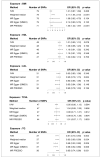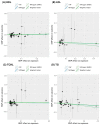Causal Association of Obesity and Dyslipidemia with Type 2 Diabetes: A Two-Sample Mendelian Randomization Study
- PMID: 36553674
- PMCID: PMC9777695
- DOI: 10.3390/genes13122407
Causal Association of Obesity and Dyslipidemia with Type 2 Diabetes: A Two-Sample Mendelian Randomization Study
Abstract
Recent studies have suggested an association between obesity and dyslipidemia in the development of type 2 diabetes (T2D). The purpose of this study was to explore the causal effects of obesity and dyslipidemia on T2D risk in Asians. Two-sample Mendelian randomization (MR) analyses were performed to assess genetically predicted obesity using body mass index (BMI) and dyslipidemia using high-density lipoprotein cholesterol (HDL), low-density lipoprotein cholesterol (LDL), total cholesterol (TCHL), and triglycerides (TG) versus T2D susceptibility using genome-wide association study (GWAS) results derived from the summary statistics of Biobank Japan (n = 179,000) and DIAbetes Meta-ANalysis of Trans-Ethnic association studies (n = 50,533). The MR analysis demonstrated evidence of a causal effect of higher BMI on the risk of T2D (odds ratio (OR) > 1.0, p < 0.05). In addition, TG showed a protective effect on the risk of T2D (ORs 0.68-0.85). However, HDL, LDL, and TCHL showed little genetic evidence supporting a causal association between dyslipidemia and T2D. We found strong genetic evidence supporting a causal association of BMI with T2D. Although HDL, LDL, and TCHL did not show a causal association with T2D, TG had a causal relationship with the decrease of T2D. Although it was predicted that TG would be linked to a higher risk of T2D, it actually exhibited a paradoxical protective effect against T2D, which requires further investigation.
Keywords: Mendelian randomization; dyslipidemia; obesity; single-nucleotide polymorphisms; type 2 diabetes.
Conflict of interest statement
The authors declare no conflict of interest. The funders had no role in the design of the study; in the collection, analyses, or interpretation of data; in the writing of the manuscript, or in the decision to publish the results.
Figures




References
Publication types
MeSH terms
Substances
LinkOut - more resources
Full Text Sources
Medical
Miscellaneous

